Koshiki-jima Revisited
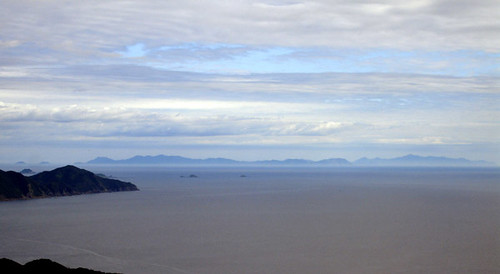
Koshikijima floats like an apparition on the horizon, 50 to 80km distant and seen in its entirety from Mt. Arao on Amakusa's west coast on an exceptionally clear day. The islands are no less mysterious and romantic than they appear from this distance.
For those not familiar with the climate here in the southwest corner of Japan, let’s say that September can still be considered a full summer month. This year was no exception, with most afternoons pushing the mercury over the 30-degree mark. Though such hot, settled weather has lately been leading us to lethargy, we decided to make full use of the month’s final weekend, what with the forecast promising exceptionally calm weather. Packing four solid paddling days into two and a half, we endeavored to do a full circuit of Koshiki-jima, including the two nearly 40km traverses required from southernmost Amakusa. Beginning the tour at 10pm on Saturday (after work), we arrived on the shores of Kami-koshiki Island by 3:30am Sunday, making excellent time on the amazingly mirror-smooth, moonlit sea. By 8am, it was too hot to sleep; we pushed on down the entire west coast of the island chain, arriving at its southern extremity two hours after sundown at 8pm. Here we camped at Teuchi port. A 6:30am start on Monday and an early supermarket box lunch on the way at Nagahama had us poised for the timely completion of northward traverse of the entire east coast: we arrived at a convenient beach near Ite-zaki by sundown. Finally, departing there at 3:15am Tuesday, we completed the open traverse back to Amakusa by 11:45 (there were waves and a headwind, contrary to the forecast). The contrast with the wild coastal cliffs and open sea that surrounded us just hours before, as experienced at Hondo’s JUSCO shopping center (where we refueled with the Colonel’s Secret Recipe), was intensely surreal. Re-acclimated to civilization, we were ready to get back to work at 3:30. Not a moment wasted on this intensive, committing, but extremely enjoyable journey.
A map showing our latest cirumnagvigation of Koshiki. Most of the traverse to and from Amakusa is not shown.
This was our third (Leanne) and fourth (Rick) visit to Koshiki, a place we are truly in love with. Our first tour involved getting our kayaks there using the ferry system – a convoluted, expensive, and time-consuming option that nevertheless led to a top-notch experience. The second tour involved traversing from Amakusa and rounding the northern Kami-koshiki Island, most of which we didn’t get to see previously. This was more intensive but likewise very rewarding (and $200 cheaper). The third time was a solo mission by Rick with the express purpose of recovering about 50kg of black sand for his new aquarium from a location noted as suitable for the purpose during the first tour – an adventure yet to be detailed here. Which brings us to the fourth and longest present tour, with statistics as follows:
Time frame: Saturday, Sep 29, 9:30PM to Tuesday, Oct 2, 11:30AM
Day 0 (Amakusa-Koshiki) 37km, 6h
Day 1 (Koshiki West Coast) 51km, 11h
Day 2 (Koshiki East Coast) 47km, 10h
Day 3 (Koshiki-Amakusa) 37km, 8½h
Totals: 172km, 35½h of paddling.
Physically, our bodies took it well, and Rick was glad for the opportunity work offered later on Tuesday for releasing much accumulated excitement and energy. There is no doubt: Koshiki is a gem: a wild, magical place of beauty and a natural aura that exerts an undeniable influence upon the psyche.
This was our third (Leanne) and fourth (Rick) visit to Koshiki, a place we are truly in love with. Our first tour involved getting our kayaks there using the ferry system – a convoluted, expensive, and time-consuming option that nevertheless led to a top-notch experience. The second tour involved traversing from Amakusa and rounding the northern Kami-koshiki Island, most of which we didn’t get to see previously. This was more intensive but likewise very rewarding (and $200 cheaper). The third time was a solo mission by Rick with the express purpose of recovering about 50kg of black sand for his new aquarium from a location noted as suitable for the purpose during the first tour – an adventure yet to be detailed here. Which brings us to the fourth and longest present tour, with statistics as follows:
Time frame: Saturday, Sep 29, 9:30PM to Tuesday, Oct 2, 11:30AM
Day 0 (Amakusa-Koshiki) 37km, 6h
Day 1 (Koshiki West Coast) 51km, 11h
Day 2 (Koshiki East Coast) 47km, 10h
Day 3 (Koshiki-Amakusa) 37km, 8½h
Totals: 172km, 35½h of paddling.
Physically, our bodies took it well, and Rick was glad for the opportunity work offered later on Tuesday for releasing much accumulated excitement and energy. There is no doubt: Koshiki is a gem: a wild, magical place of beauty and a natural aura that exerts an undeniable influence upon the psyche.
The west coast of Shimo-Koshiki-jima near Imuta. Mile upon mile of such scenery continue uninterrupted along these coasts.
For coastal beauty, Koshiki is unmatched in Kyushu, in itself a place by no means starved of scenic seaside. But Koshiki has the most in terms of amount, size, and grandeur, especially relative to the size of the islands themselves. Some statistics done on available GIS data show that in an area roughly 40x12km in size, there is about 207km of coastline, yet “only” 37km (18%) bears the mark of man (in Japan, that is nearly always a bad thing scenically). By contrast, the national average is about 40%, and nearby Amakusa seems to have even more. Koshiki Islands in their entirety are so incredibly rugged that in spite of its best efforts, the Japanese construction machine, formidable and well greased as it is, grinds to a halt here. That there is no point in concreting uninhabitable coastline is sometimes not enough to stop various engineering efforts, but here, the sea cliffs are so precipitous and imposing that it is just plain impossible to touch them. The concrete in Koshiki is limited to the scattered nooks between the cliffy mountains and the sea where the islands’ tiny towns and villages are nestled, and of course to the pointless yet numerous roads contouring the mountainous slopes; these latter are, however, so high up above the coast that they are difficult to spot from the seaside. Of course, a mere enumeration of the damage done to a landscape by man does not normally guarantee its beauty. But in Japan, because of the ubiquity of such damage, it does seem to be a pretty good index in general.
The village of Imuta is fairly typical of a Koshiki population center. Heavy involvement of government sponsored construction has created an appearance that belies the village's modest reality.
Koshiki’s outlying location and low population make the surrounding seas significantly clearer than most of the rest of the Kyushu coast, adding further quality to the unspoiled vistas. Transparent, fresh-smelling seas are always eagerly sought, yet not so frequently found, by us. But the crowning touch of these islands’ beauty is something not so clearly definable. Perhaps it is the quality of the rocks and cliffs, so changable in character: huge scree landslides giving way to dark gray rotten shale behemoths split by igneous intrusions of different colors, morphing into delicately layered gray sandstones in overhanging cliffs like upside-down staircases, then subtly changing into hard ochre sandstone monoliths hundreds of meters high, vaguely reminiscent of the American desert southwest. All these formations are endowed with spectacular outlying pinnacles and various caves at water level, full of surprises waiting to be explored. So it happens that of the 170km of natural coastline here, we consider at least 110km to be ‘outstanding’ of quality and interest to exploration; while the remainder can be labeled ‘interesting’ at least. Could a coastal kayaker possibly ask for more?
Kayaks are dwarfed by the majesty of the Koshiki coast. A rather adventurous trail leads up from this point over the spine of the island and the town on the other side...
Leanne carefully makes her way down the selfsame trail; typically, once built, such trails go completely unmaintained and quickly fall into a state of disrepair such as this.
One final point to be considered, one that makes the place just about perfect in our minds, is this. Besides the rugged coastal beauty, and a small amount of cultural heritage in the villages (like the attractive cobble walls along the old alleys in Teuchi we discovered this time around), these islands are not capable of offering that much more to the visitor. Sport fishing is certainly great, but the expense and inconvenience of getting here put off the multitudes. Where in Amakusa, we may see a hundred or more expensively outfitted men perched on the seaside rocks on any given day, in Koshiki we see less than a dozen. It’s not likely the place will ever be commercialized and hyped up as the next amazing travel destination. Not unless the sea kayaker population in Japan increases by a thousand-fold. And that just does not seem to be in the offing.
A scene from the east coast.
More east coast scenery, near a point called Mitare. Many more kilometers of beautiful coast stretched yet ahead of us at this point.
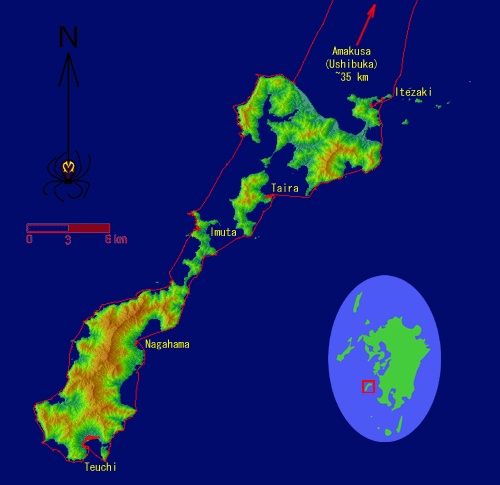
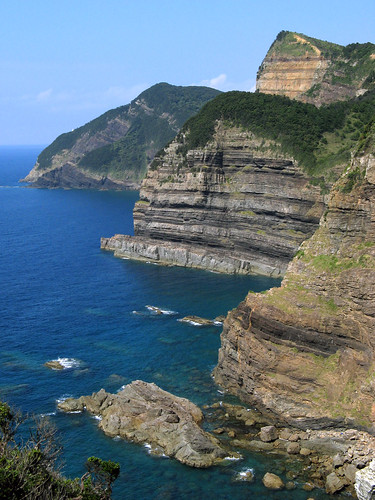
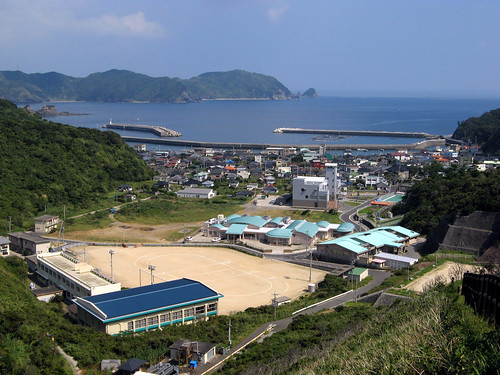
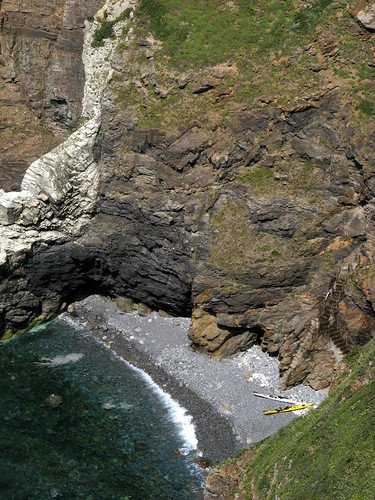
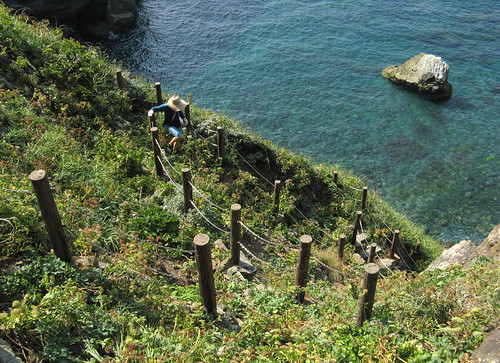

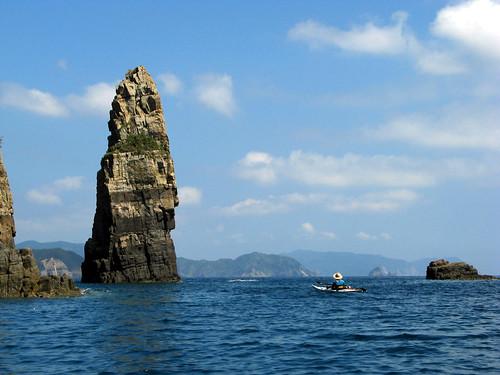


4 Comments:
paddling along a coast like this is something i would definitely like to do
By lubo, at 9:38 am
lubo, at 9:38 am
Dear Rik and Leanne,
I have been following your adventures for a few months now, but your last entry has prompted this first mail! To have come from work and by the sounds of it, back straight in to work, that was one crazy trip, but when you see the stuff you can see down there, I understand 100%!! Well done! Keep posting these great posts! They are my inspiration up here in the big smoke where getting anywhere takes a bit more resolve!
Happy paddling and biking and climbing and teaching!
Mick
By Mick and Miki Tan, at 10:29 am
Mick and Miki Tan, at 10:29 am
hi lubo: yeah, it was so much fun leanne wants to go every weekend and we would if it were not for the 40km stretch of sea in between. maybe when you come here next, we could go?
and mick: thanks for posting an enthusiastic note; we put this blog together in the hope there are people out there 'in the woodwork' who might read, see and enjoy. we are genuinely glad you do.
By Leanne and Rik Brezina, at 1:22 am
Leanne and Rik Brezina, at 1:22 am
I lived in Teuchi in Koshiki for two years. It is an amazing little community surrounded by natural beauty. Some of the best moments of my life were spent there. I would recommend to anybody to visit Koshikijima!! I enjoyed reading about your adventures in your blog.
By Unknown, at 11:29 am
Unknown, at 11:29 am
Post a Comment
<< Home